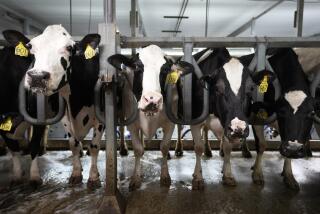Parallels Seen in Fatal Human and Cattle Diseases
- Share via
On Feb. 11, 1985, a day before Alison Lay died in Winchester, England, a cow in the neighboring county of West Sussex died from a bizarre and undiagnosed disease.
As it wasted, veterinarians could only wonder at unfamiliar symptoms. Its milk dried up, its back arched, its head trembled and it slipped uncontrollably in the paddock.
The cause remained uncertain for more than a year. Although Creutzfeldt-Jakob disease, or CJD, was rare in young people, it was at least identifiable. But CJD-like diseases were unknown in cattle.
In April 1986, government veterinarians finally named the new disease bovine spongiform encephalopathy, or BSE. It was, they confirmed, a new cattle form of the human and sheep diseases, CJD and scrapie, respectively.
Meanwhile, the case of Alison Lay remained professional worlds away. Her case was a medical tragedy; the cow’s disease was a burgeoning agricultural crisis.
The working hypothesis held that BSE, by then nicknamed “mad cow disease,” had jumped from sheep to cows via contaminated cattle rations, which had included ground-up livestock carcasses.
Only recently has this notion been challenged. Currently under scrutiny by a British inquiry is the suggestion that pituitary-derived hormones caused both the human and the cattle epidemics.
“They are mirror images,” said Dr. Anne Maddocks, a disease control officer who handled the earliest British cases of Lassa fever, Legionnaire’s disease and AIDS at London’s largest teaching hospital, St. Mary’s. Animal feed, contends Maddocks, was not the cause of BSE. It only “amplified” the number of cases in cattle.
The common factor here, she said, is that at the same time human growth hormone, extracted from the pituitaries of cadavers, was being given to children, pituitary-derived bovine hormones were in wide use on farms.
Albert Parlow, research professor of obstetrics and gynecology at the UCLA School of Medicine, calls Maddocks’s idea a “tantalizing hypothesis. . . . The extracts of the pituitary glands that were used in these animals were very crude--far more crude than the human growth hormone preparations.”
To date, Britain has had more than a million cases of BSE in cattle (most of which scientists estimate entered the human food supply undetected), and now 67 cases of a “new variant CJD” among young people thought to have been infected by tainted cattle products.
The British BSE inquiry will report its findings in the autumn. Maddocks’ submission, along with evidence from more than 1,000 witnesses, can be found on the Internet at https://www.bse.org.uk.






